
The national flag of Poland consists of two horizontal stripes of equal width, the upper one white and the lower one red. The two colours are defined in the Polish constitution as the national colours. A variant of the flag with the national coat of arms in the middle of the white fess is legally reserved for official use abroad and at sea. A similar flag with the addition of a white eagle is used as the naval ensign of Poland.

The Bielsko Voivodeship was a voivodeship (province) of the Polish People's Republic from 1975 to 1989, and the Third Republic of Poland from 1989 to 1998. Its capital was Bielsko-Biała. It was established on 1 June 1975, from the parts of the voivodeships of Katowice, and Kraków, and existed until 31 December 1998, when it was partitioned between then-established Lesser Poland, and Silesian Voivodeships.

The coat of arms of Poland is a white, crowned eagle with a golden beak and talons, on a red background.

The Constitution of the Republic of Poland is the supreme law of the Republic of Poland, which is also commonly called the Third Polish Republic in contrast with the preceding systems.
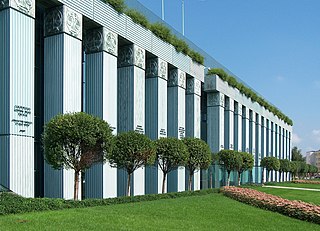
The Supreme Court is the highest court in the Republic of Poland. It is located in the Krasiński Square, Warsaw.

The coat of arms that serves as the symbol of the Lublin Voivodeship, Poland depicts a white (silver) male jumping cervus (deer), with a yellow (golden) crown on its neck, placed on a red background. The current design of the coat of arms was designed by Andrzej Heidrich, and adopted in 2002.

Throughout most of the history of Poland, the banner of Poland was one of the main symbols of the Polish State, normally reserved for use by the head of state. Although its design changed with time, it was generally a heraldic banner, i.e., one based directly on the national coat of arms: a crowned White Eagle on a red field. The banner should not be confused with the flag of Poland, a white and red horizontal bicolor, officially adopted in 1919.

God, Honour, Fatherland or Honour and Fatherland is one of the unofficial mottos of Poland. It is commonly seen as the motto of the military of Poland, and has been confirmed as such by several Polish legal decrees.

Military eagles are military insignia used in the Polish Armed Forces, based on the White Eagle of the Polish coat of arms. They are used on elements of military uniforms such as hats and buttons, as well as on military banners, flags, medals, emblems, publications etc. One variant exists for each of the five branches of the Armed Forces. Additionally, the Minister of National Defence, the Marshal of Poland, and generals and admirals use their own variants.

The naval ensignof the Republic of Poland is a swallowtailed horizontal bicolor of white and red with the national coat of arms in the middle of the white stripe. It has been used by the Polish Navy since 1919.
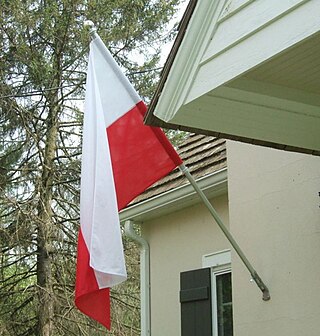
The Polish National Flag Day, also known as the Day of the Flag of the Republic of Poland, is a national holiday in Poland which takes place on 2 May every year. The holiday is celebrated on the day between two national holidays: 1 May and 3 May.

The coat of arms of the Lesser Poland Voivodeship, Poland features a white (silver) eagle with a yellow (golden) crown on his head that is turned left, a beak, legs, and a stripes on its wings, with the charge placed on the red background. It was designed by Wojciech Drelicharz, Zenon Piech, and Barbara Widłak, and adopted in 1999.
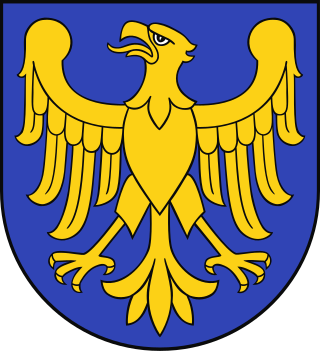
The coat of arms, that serves as the symbol of the Silesian Voivodeship, Poland, features a yellow (golden) eagle on a blue background. The current version of the coat of arms was adopted in 2001, and based on the historical coats of arms of Upper Silesia.
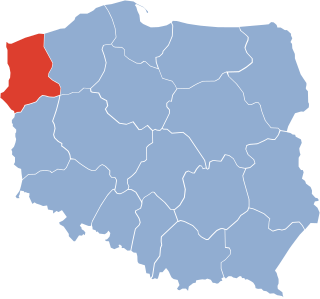
The Szczecin Voivodeship was a voivodeship (province) with its capital in Szczecin, that was centered on the Farther Pomerania. It existed from 1946 to 1975. Until 19 February 1947 it was under the administration of Provisional Government of National Unity, which then was replaced by the Polish People's Republic. It was established on 28 June 1946, when it was carved out of the territory of the District of the Western Pomerania, and parts of the Gdańsk, and Pomeranian Voivodeships. On 6 July 1950, its eastern half was incorporated into then-established Koszalin Voivodeship, and the voivodeship ceased to exist on 31 May 1975, when it was replaced by then-established Szczecin and Gorzów Voivodeships.

The Warsaw Voivodeship was a voivodeship (province) of the Polish People's Republic, with capital in Warsaw, that was located in Masovia. It was established on 22 August 1944, and until 28 June 1945, it remained under the administration of the Provisional Government of the Republic of Poland, which then was replaced by the Provisional Government of National Unity. On, 19 February 1947, the provisional government was replaced by the Polish People's Republic. It existed until 31 May 1975, when it was partitioned into the voivodeships of Biała Podlaska, Białystok, Ciechanów, Lublin, Łomża, Ostrołęka, Płock, Radom, Siedlce, Skierniewice, and Warsaw Capital.

The Koszalin Voivodeship was a voivodeship (province) of the Polish People's Republic, with capital in Koszalin, that existed from 1950 to 1975. It was established on 6 July 1950, from the eastern half of the Szczecin Voivodeship, and existed until 31 May 1975, when it was partitioned between then-established voivodeships of Koszalin, Słupsk, and Piła.
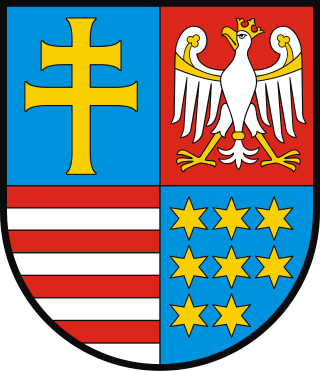
The coat of arms that serves as the symbol of the Świętokrzyskie Voivodeship, Poland, consists of the Iberian style escutcheon (shield), with square top and rounded base, that is divided in the 2 by 2 chessboard pattern. The top left field features a yellow patriarchal cross. The top right field features a white eagle with yellow crown, beak, legs, stripes on its wings, and a ring on its tail. The bottom left field features eight yellow six-pointed starts, placed in three rows, each with three stars, with the exception of the bottom row, that only had 2 stars, placed to the left.
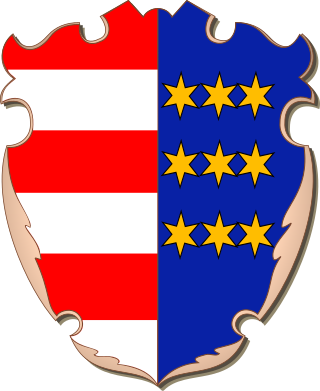
The historical coat of arms, that served as the symbol of the Sandomierz Land, and the Sandomierz Voivodeship of the Kingdom of Poland, from 14th to 18th centuries, was divided into two fields, with the left field consisting of six stripes, that were alternatining either between red and white, or red and yellow colours, and with the right field consisting of several yellow six-armed stars, which number altered between seven and nine.












































